![]() Animal Man, Volume 1 (Issues 1-9) by Grant Morrison (writer), Chas Truog (artist, Issues 1-8) and Tom Grummett (artist, Issue 9)
Animal Man, Volume 1 (Issues 1-9) by Grant Morrison (writer), Chas Truog (artist, Issues 1-8) and Tom Grummett (artist, Issue 9)
 The twenty-six issue run on Animal Man by Grant Morrison is one of the most important works in comics, but it must be understood in an historical and artistic context; otherwise, someone new to comics might just flip through it and see what looks like a slightly-dated comic with artwork that isn’t currently as exciting and flashy and polished and colorful as newer comics. However, this twenty-five-year old comic is of higher quality than most of what is still put out on a monthly basis a quarter-of-a-century later. Most of the high quality comics being written today and aimed toward mature, intelligent audiences were made possible by and are a direct result of the risks Morrison took in writing the issues in this first volume of Animal Man. Because of its significance, I want to attempt to do full justice in this essay review to what has become a canonical work in modern comics.
The twenty-six issue run on Animal Man by Grant Morrison is one of the most important works in comics, but it must be understood in an historical and artistic context; otherwise, someone new to comics might just flip through it and see what looks like a slightly-dated comic with artwork that isn’t currently as exciting and flashy and polished and colorful as newer comics. However, this twenty-five-year old comic is of higher quality than most of what is still put out on a monthly basis a quarter-of-a-century later. Most of the high quality comics being written today and aimed toward mature, intelligent audiences were made possible by and are a direct result of the risks Morrison took in writing the issues in this first volume of Animal Man. Because of its significance, I want to attempt to do full justice in this essay review to what has become a canonical work in modern comics.
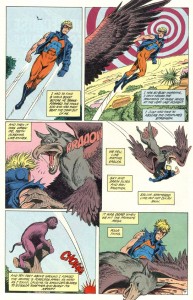 Grant Morrison, born in 1960, is from Scotland and is part of the wave of writers recruited by DC when they decided to look beyond the U.S. for new talent (most of them recruited personally by long-time Vertigo editor Karen Berger). Along with a handful of American writers like Frank Miller in the 1980s, this wave of talent from the U.K. is what helped comics mature in the United States: In 1984, Alan Moore took the minor character Swamp Thing and turned the title into one of the most important DC titles. In 1988, Neil Gaiman recreated the entire concept of Sandman and made him part of a new mythology based on the seven eternal entities he named the Endless: Dream (or Sandman), Death, Desire, Despair, Delirium, Destiny, and Destruction. Morrison was equally revolutionary in his revamping of the extremely minor character Animal Man.
Grant Morrison, born in 1960, is from Scotland and is part of the wave of writers recruited by DC when they decided to look beyond the U.S. for new talent (most of them recruited personally by long-time Vertigo editor Karen Berger). Along with a handful of American writers like Frank Miller in the 1980s, this wave of talent from the U.K. is what helped comics mature in the United States: In 1984, Alan Moore took the minor character Swamp Thing and turned the title into one of the most important DC titles. In 1988, Neil Gaiman recreated the entire concept of Sandman and made him part of a new mythology based on the seven eternal entities he named the Endless: Dream (or Sandman), Death, Desire, Despair, Delirium, Destiny, and Destruction. Morrison was equally revolutionary in his revamping of the extremely minor character Animal Man.
All these comics became a part of or helped start Vertigo, DC’s adult-themed line of comics. Other major writers from the U.K. include Jamie Delano, Peter Milligan, and Garth Ennis. None of them were derivative of one another or imitated the work of the others, but they all had one thing in common: They treated the characters in U.S. comics very seriously, and they wrote comics as adults writing for other adults, or at least very mature teenagers. I hope to deal with all these writers and their works in the future, even working through the individual story arcs of Sandman to compliment the review of the entire series as a whole we already have on the site. Today, in turning to Animal Man, I am backing up to the late 1980s to see some earlier writing done by the British Wave of authors.
Buddy Baker, Animal Man, is a fairly goofy character, to be honest. Some kind of spaceship landed and exploded and gave him the ability to absorb the powers of animals for a short period of time. He has to be in the vicinity of the specific animal whose power he channels. He doesn’t fully understand his powers or even, when the comic opens with issue one, seem to have bothered to try to figure out the extent of them. He’s not much of a hero. His suit is silly looking like many superhero outfits. It even has a big letter “A” on the front of it.
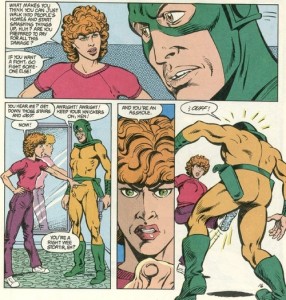 Morrison, however, makes this goofy guy a great character precisely because he’s so goofy and normal and so much like us. Morrison portrays him as an everyman. He’s insecure. He wants to be a hero but doubts himself. He lives a suburban life and hangs out with the neighbors. He’s even married and has two kids, Cliff and Maxine. What I love about Buddy Baker is that not only does he have a family, unlike most superheroes, but he also actually spends most of his time with them. He loves his kids, even when his nine-year-old son, Cliff, is talking back to him. He loves his wife and his wife loves him. But she gets frustrated with him. In other words, she helps make clear that Buddy Baker is more everyman than superhero.
Morrison, however, makes this goofy guy a great character precisely because he’s so goofy and normal and so much like us. Morrison portrays him as an everyman. He’s insecure. He wants to be a hero but doubts himself. He lives a suburban life and hangs out with the neighbors. He’s even married and has two kids, Cliff and Maxine. What I love about Buddy Baker is that not only does he have a family, unlike most superheroes, but he also actually spends most of his time with them. He loves his kids, even when his nine-year-old son, Cliff, is talking back to him. He loves his wife and his wife loves him. But she gets frustrated with him. In other words, she helps make clear that Buddy Baker is more everyman than superhero.
She’s not merely a weak, supporting character, however. In fact, she’s another reason why the comic is so great. Ellen is a strong character. She has a full-time job and supports the family. She’s good-looking, yes, but she’s physically strong: At one point, she gives a quick kick to the groin of Mirror Master and then kicks him down the stairs because he’s beating up HER husband in HER house. She is not the quiet, submissive type. She is one of the most well-rounded women I’ve ever encountered in what is supposed to be a superhero comic written for males. She puts up with Buddy’s whining and his seeming mid-life crisis when he starts to go vegetarian, forcing the family to follow his new interest with him as he goes through the refrigerator and freezer to throw out all their groceries containing meat. Ellen does not put down his new ideals, but she’s practical: She wants to know what the family’s going to eat and how they are going to buy some new food. Throughout the comic, she plays an active role as a real woman who has to put up with — not serve or worship — a husband who happens to be a superhero.
Like Ellen, Buddy’s son and daughter aid in conveying a sense of realistic domestic living as well. His daughter draws pictures for him and is concerned with baby kittens. His son is having problems with bullies at school, and if his father can’t help with his problems, then he doesn’t seem that excited about having a superhero father. In fact, he realizes it can be a real pain, as when his father decides they are going to become vegetarian. Cliff isn’t very excited about the idea of tofu. However, like a typical son, he runs from the room when he sees that his mom and dad are about to have a little spat when mom sees what dad’s doing with the food in the kitchen. These are realistic touches of domesticity one just never sees in mainstream superhero comics.
So we have a strong woman and a family man, but what makes this domestic comic great? For me, it’s that it functions on at least a double level. On one level, it’s fairly understandable. This crucial level is rarely talked about when it comes to Morrison’s Animal Man. On this level, the comic is a slight critique of the SUPER hero. Morrison asks and answers these questions: What if a superhero had a family and doubts and no job and wasn’t part of a major superhero group (until later in Volume One)? How would his specific powers change his worldview and daily habits? What would he think of wearing a typical, skin-tight costume? Morrison makes all of Buddy Baker’s reactions realistic once we accept the basic premise that he could even have these powers: He becomes a vegetarian, he talks to his family about his doubts, and he expresses how self-conscious he feels wearing the suit: “It’s kind of embarrassing wearing a skin-tight costume,” he tells his wife. He even adds a jacket, commenting that it will help him carry around some money and other necessary items all people need when heading out of the house.
On this first level, the comic is even a bit didactic. Buddy Baker fights for animal rights and helps out some animal rights groups. He becomes a vegetarian. Morrison even addresses other real-life issues, including the attempted rape of Buddy’s wife and the use of live animals for scientific research. This didacticism is conveyed clearly and is as well-done in a comic as is possible, certainly building on the didacticism of Denny O’Neil’s Green Lantern/Green Arrow stories starting in 1970.
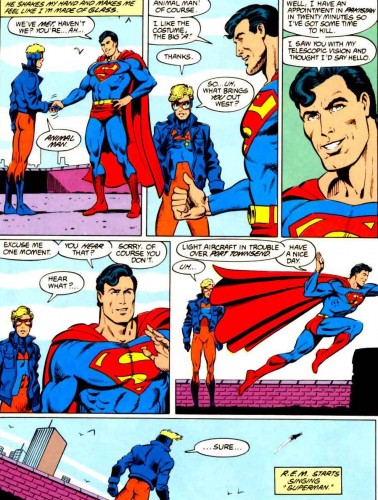 As much as I love those clear messages in the Green Lantern/Green Arrow comics and Morrison’s ability to follow in their footsteps with the animal-rights and environmental issues relevant to Animal Man, the second level of Morrison’s Animal Man is what makes the comic so revolutionary as a work of art. In fact, I don’t know whether to give this first Volume a 4.5 because it’s not as good as some of Morrison’s later work (with the exception of Issue #5) or to give it a 5.5 because, based on the time it was written, it’s off the scale in challenging conventional story-telling techniques in main-stream comics. Morrison manages to write a meta-comic, a comic that is very aware of itself as a comic: Some, but not all, of the characters in the book become aware that they are actually part of a comic book reality. This self-aware writing is not new to literature, and I’m sure we can find precedent for it even in comics before Animal Man, but Morrison’s work is revolutionary in that he did it working for the major company DC on a character that was a part of mainstream continuity (even if a minor part). Animal Man talks with Superman and Martian Manhunter. Given the level of artistic experimentalism, we should find it surprising that Animal Man is not a character written for an independent publisher or relegated to an area of the DC universe where he’s prevented from interacting with major characters like Superman.
As much as I love those clear messages in the Green Lantern/Green Arrow comics and Morrison’s ability to follow in their footsteps with the animal-rights and environmental issues relevant to Animal Man, the second level of Morrison’s Animal Man is what makes the comic so revolutionary as a work of art. In fact, I don’t know whether to give this first Volume a 4.5 because it’s not as good as some of Morrison’s later work (with the exception of Issue #5) or to give it a 5.5 because, based on the time it was written, it’s off the scale in challenging conventional story-telling techniques in main-stream comics. Morrison manages to write a meta-comic, a comic that is very aware of itself as a comic: Some, but not all, of the characters in the book become aware that they are actually part of a comic book reality. This self-aware writing is not new to literature, and I’m sure we can find precedent for it even in comics before Animal Man, but Morrison’s work is revolutionary in that he did it working for the major company DC on a character that was a part of mainstream continuity (even if a minor part). Animal Man talks with Superman and Martian Manhunter. Given the level of artistic experimentalism, we should find it surprising that Animal Man is not a character written for an independent publisher or relegated to an area of the DC universe where he’s prevented from interacting with major characters like Superman.
I also am impressed that Morrison’s willingness to push the meta-narrative quality of the comic so far that it’s almost impossible to make sense of everything did not prevent the comic from selling or get him kicked off the comic immediately. As he says only half-jokingly in the introduction to this volume about the popularity of the most challenging writing he did in these first issues, I was “encouraged . . . to go on to produce the entirely unreadable gibberish which has since become my stock-in-trade.” I think the first level of the comic that I discussed, because it is realistic and often clearly didactic, made it possible for readers to stay with the comic. Ultimately, I think the secret to Morrison’s success is this combination of levels: At the same time he asks large philosophical questions that make your mind want to explode, he gives us as readers a clear story to follow. He never forgets that comics are meant to tell understandable stories. He just wants to study the nature of stories at the same time he is telling the story. This dual purpose is both the trademark and the genius of Grant Morrison’s work.
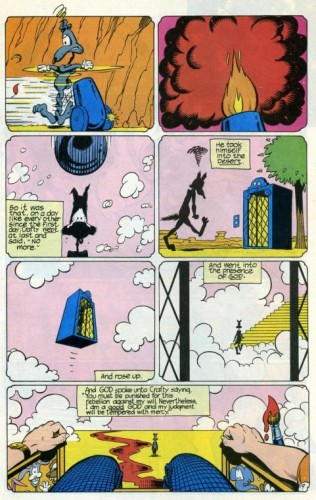 I don’t want my appraisal of his work to suggest Morrison uses a simplistic formula: straight-forward didactic storyline + complex philosophic metanarrative = popular and critical success. Though that formula is present and does have that result as a product of the equation, he has themes that are rich in meaning beyond mere self-conscious metanarrative. In other words, he’s not a one-trick pony. Not only does he vary the ways in which he touches on the subject of metanarrative, he also has rich thematic interests that are neither simplistic and didactic or concerned primarily, or at least solely, with metanarrative. The first story arc — what was actually supposed to be the only story arc — involves Animal Man’s getting the chance to beat up some large, dangerous beasts and deliver to our satisfaction the punishment of an experimental scientist. But the big bad guy he finally tracks down turns out to require sympathy both from the reader and Animal Man. The structure of the superhero story is present: Animal Man does fight an opponent. So Morrison satisfies our urge for typical comic book narrative. However, by showing that this opponent is neither a villain nor even bad at all, Morrison calls into question our desire for such a narrative to begin with. It’s quite brilliant and subtly subversive. And it was certainly good enough at the story-telling level for DC to ask him to continue writing the Animal Man series after this first four-issue story arc finished.
I don’t want my appraisal of his work to suggest Morrison uses a simplistic formula: straight-forward didactic storyline + complex philosophic metanarrative = popular and critical success. Though that formula is present and does have that result as a product of the equation, he has themes that are rich in meaning beyond mere self-conscious metanarrative. In other words, he’s not a one-trick pony. Not only does he vary the ways in which he touches on the subject of metanarrative, he also has rich thematic interests that are neither simplistic and didactic or concerned primarily, or at least solely, with metanarrative. The first story arc — what was actually supposed to be the only story arc — involves Animal Man’s getting the chance to beat up some large, dangerous beasts and deliver to our satisfaction the punishment of an experimental scientist. But the big bad guy he finally tracks down turns out to require sympathy both from the reader and Animal Man. The structure of the superhero story is present: Animal Man does fight an opponent. So Morrison satisfies our urge for typical comic book narrative. However, by showing that this opponent is neither a villain nor even bad at all, Morrison calls into question our desire for such a narrative to begin with. It’s quite brilliant and subtly subversive. And it was certainly good enough at the story-telling level for DC to ask him to continue writing the Animal Man series after this first four-issue story arc finished.
This trade includes five more issues of absolute amazing storytelling. If a reader in 1988 didn’t know he was reading something new by the end of the first arc, Issue #5 — “The Coyote Gospel” — made clear that Morrison was a writer to keep an eye on. As he acknowledges in his introduction to this volume, this story remains one of his favorites, but at the time, he writes, “I was utterly convinced that what I was writing was absolute unreadable gibberish and that it would hammer the final nail into the coffin of my fledgling career as a writer of American super-hero comics.” The story was a complete success, became very popular and remains one of his most well-known and most appreciated stories by fans of comics in general and Grant Morrison in particular.
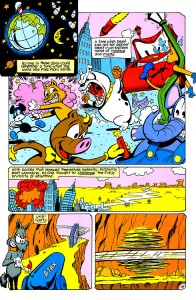 What is so shocking AND appealing about this story? The coyote character in the comic is reminiscent of the coyote always being bested by the Roadrunner in the popular cartoon series. The cartoon character coyote — named Crafty in Morrison’s comic — delivers a message about his reality and his questioning of it to the comic book character Animal Man, whose response is key to the entire Animal Man series as written by Grant Morrison as he teases us in the intro to volume one: “’Coyote Gospel’ initiated a plotline which was ultimately resolved in Animal Man #26″ (completed in Animal Man, Volume 3). Comic book characters questioning their Gods, or god-like creators, remains one of Morrison’s primary concerns to this day. He seems to be talking as much about the process as making art as he’s talking about our questioning our own reality and gods. Questions of aesthetics are not esoteric questions for Morrison. They are not merely aesthetic theoretical questions with no real-life relevance. To ask about meaning in art IS to ask about meaning in life for Morrison.
What is so shocking AND appealing about this story? The coyote character in the comic is reminiscent of the coyote always being bested by the Roadrunner in the popular cartoon series. The cartoon character coyote — named Crafty in Morrison’s comic — delivers a message about his reality and his questioning of it to the comic book character Animal Man, whose response is key to the entire Animal Man series as written by Grant Morrison as he teases us in the intro to volume one: “’Coyote Gospel’ initiated a plotline which was ultimately resolved in Animal Man #26″ (completed in Animal Man, Volume 3). Comic book characters questioning their Gods, or god-like creators, remains one of Morrison’s primary concerns to this day. He seems to be talking as much about the process as making art as he’s talking about our questioning our own reality and gods. Questions of aesthetics are not esoteric questions for Morrison. They are not merely aesthetic theoretical questions with no real-life relevance. To ask about meaning in art IS to ask about meaning in life for Morrison.
The four remaining stories, though not quite at the level of “Coyote Gospel,” are equally interesting and fun. We meet Hawkman and some other members of his race, one of whom is an artist whose works operate on a destructive planetary level. Buddy doesn’t do a very good job defeating this artist/villain, so maybe that’s why Morrison, in the next issues, lets Buddy run into an older, retired villain who was never very good to begin with. 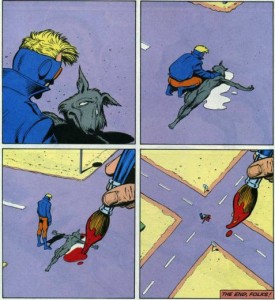 Nobody even knows his name. He’s so bad and depressed, Buddy has to play the role of a suicide line operator. Continually failing, Buddy then has his home invaded by The Mirror Master who is there to deliver a warning and severe threats, accompanied by some physical roughing up so the message is convincing. Ellen’s tongue-lashing and swift kick deliver more of a beating than poor Buddy is capable of. He’s not bumbling — I want to be clear about that — he’s just not great at being a hero in volume one. He’s a family man with a good heart and good ethical principals. But he struggles with his role as both a father and a superhero.
Nobody even knows his name. He’s so bad and depressed, Buddy has to play the role of a suicide line operator. Continually failing, Buddy then has his home invaded by The Mirror Master who is there to deliver a warning and severe threats, accompanied by some physical roughing up so the message is convincing. Ellen’s tongue-lashing and swift kick deliver more of a beating than poor Buddy is capable of. He’s not bumbling — I want to be clear about that — he’s just not great at being a hero in volume one. He’s a family man with a good heart and good ethical principals. But he struggles with his role as both a father and a superhero.
The final issue of the first volume features the Martian Manhunter — one of my personal favorite DC characters. Buddy spends time asking him for help, and he provides it, even taking time to help Buddy’s son with one of his problems as well, a nice final touch that Morrison adds to let us know that Buddy’s self-doubt isn’t misplaced. His powers aren’t working well anymore, so he might get kicked out of the Justice League Europe just after getting in. Even when they were working, he wasn’t very effective after the first four issues.
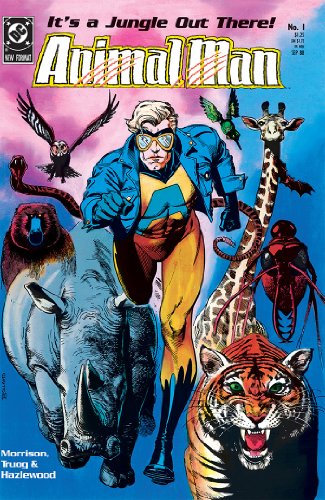 Once we finish the entire volume, we realize that Morrison has tricked us into reading a superhero comic about a guy who isn’t even that great at being a superhero. However, as I hope I’ve made clear, this “superhero” comic is still better than most other superhero comics. It has a clear message without being boring. It has villains who aren’t very bad, but we still get plenty of superhero fights. And finally, it has a metanarrative side to it that rivals some of the greatest postmodern novels in their questioning the “reality” of our world by having characters who question the “reality” of their world. I’ve also managed to write a lengthy review without giving many significant plot spoilers (other than about the Coyote). In other words, there’s so much in the comic that one could write about it for days without running out of ideas to talk about. Morrison, apparently, generates concepts and ideas and plots at an incredibly fast pace, and his comics overflow with them, even in his earliest American work on Animal Man.
Once we finish the entire volume, we realize that Morrison has tricked us into reading a superhero comic about a guy who isn’t even that great at being a superhero. However, as I hope I’ve made clear, this “superhero” comic is still better than most other superhero comics. It has a clear message without being boring. It has villains who aren’t very bad, but we still get plenty of superhero fights. And finally, it has a metanarrative side to it that rivals some of the greatest postmodern novels in their questioning the “reality” of our world by having characters who question the “reality” of their world. I’ve also managed to write a lengthy review without giving many significant plot spoilers (other than about the Coyote). In other words, there’s so much in the comic that one could write about it for days without running out of ideas to talk about. Morrison, apparently, generates concepts and ideas and plots at an incredibly fast pace, and his comics overflow with them, even in his earliest American work on Animal Man.
I’ll return in future columns to review other great work by Morrison, but for now, one could do worse than starting at Morrison’s beginning in the U.S.. Perhaps Zenith, an even earlier British comic by Morrison, will be published in the U.S. one day, but for now, order volume one of Animal Man. If Frank Miller and Alan Moore made American comics gritty, Alan Moore and Grant Morrison helped make them philosophical. I really can’t recommend Animal Man enough.



Trackbacks/Pingbacks